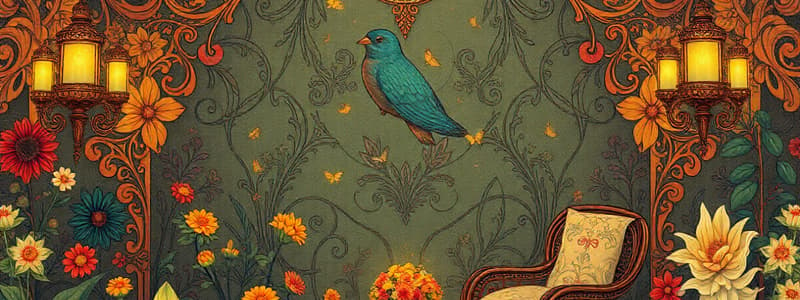Podcast
Questions and Answers
What are the primary colors of light in the additive color system?
What are the primary colors of light in the additive color system?
- Red, Green, Blue (correct)
- Red, Orange, Purple
- Yellow, Green, Violet
- Red, Yellow, Blue
What is the result of mixing the primary colors red, blue, and yellow in equal amounts?
What is the result of mixing the primary colors red, blue, and yellow in equal amounts?
- Gray
- Brown
- Black (correct)
- White
Which of the following is considered a tertiary color?
Which of the following is considered a tertiary color?
- Orange
- Red
- Violet
- Red-Orange (correct)
Which color is considered a secondary color?
Which color is considered a secondary color?
What does the term 'local color' refer to?
What does the term 'local color' refer to?
Which of the following colors is not a neutral color?
Which of the following colors is not a neutral color?
What happens when you mix equal amounts of red, green, and blue light?
What happens when you mix equal amounts of red, green, and blue light?
What is meant by 'values of color'?
What is meant by 'values of color'?
What is produced by adding white to a hue?
What is produced by adding white to a hue?
Which colors are found directly across from each other on the color wheel?
Which colors are found directly across from each other on the color wheel?
Which of the following color schemes includes colors that are next to each other on the color wheel?
Which of the following color schemes includes colors that are next to each other on the color wheel?
What effect do warm colors have in a painting or drawing?
What effect do warm colors have in a painting or drawing?
How are monochromatic colors defined?
How are monochromatic colors defined?
What is a characteristic of complementary color pairs?
What is a characteristic of complementary color pairs?
Which of the following does NOT belong to the warm color family?
Which of the following does NOT belong to the warm color family?
What role does the color wheel play for artists?
What role does the color wheel play for artists?
Flashcards
Tint
Tint
A hue created by adding white to a color.
Shade
Shade
A hue created by adding black to a color.
Color Wheel
Color Wheel
A visual representation of color relationships, organizing primary, secondary, and intermediate colors in a circular chart.
Monochromatic Color Scheme
Monochromatic Color Scheme
Signup and view all the flashcards
Complementary Colors
Complementary Colors
Signup and view all the flashcards
Analogous Colors
Analogous Colors
Signup and view all the flashcards
Warm Colors
Warm Colors
Signup and view all the flashcards
Cool Colors
Cool Colors
Signup and view all the flashcards
Additive Color Mixing
Additive Color Mixing
Signup and view all the flashcards
Subtractive Color Mixing
Subtractive Color Mixing
Signup and view all the flashcards
Primary Colors
Primary Colors
Signup and view all the flashcards
Secondary Colors
Secondary Colors
Signup and view all the flashcards
Tertiary Colors
Tertiary Colors
Signup and view all the flashcards
Local Color
Local Color
Signup and view all the flashcards
Neutral Colors
Neutral Colors
Signup and view all the flashcards
Color Value
Color Value
Signup and view all the flashcards
Study Notes
Color Theory
- Color is a fundamental element in art.
- Light is composed of various colors.
- Visible light spectrum includes red, orange, yellow, green, blue, indigo, violet.
- Color can create the illusion of three dimensions.
Additive Mixing
- Additive mixing describes how colors are created from light.
- Primary colors in light are red, green, and blue.
- Mixing these in equal amounts creates white.
- This effect is used in theater lighting, television, and computer displays.
Subtractive Mixing
- Subtractive mixing describes how colors are created from pigments (like paint).
- Primary colors in pigments are red, yellow, and blue.
- Mixing these in equal amounts creates black.
- Mixing different pigments results in different colors.
Primary Colors
- Primary colors are the fundamental colors.
- Red, yellow, and blue are the primary colors.
- They cannot be created by mixing other colors.
Secondary Colors
- Secondary colors are made by mixing two primary colors.
- The secondary colors are orange, green, and purple (violet).
Tertiary Colors
- Tertiary colors are created by mixing a primary and a secondary color.
- Examples include red-orange, yellow-orange, yellow-green, blue-green, blue-violet, and red-violet.
Local Color
- Local color refers to realistic colors as they are observed in nature.
- Examples include green grass, blue sky, and brown earth.
Neutral Colors
- Neutral colors include black, white, gray, and sometimes brown.
- These colors contain roughly equal parts of all three primary colors.
Values of Color
- Value refers to the lightness or darkness of a color.
- It's achieved by adding white (creating tints) or black (creating shades) to a hue.
Tints and Shades
- Tints are created by adding white to a hue.
- Shades are created by adding black to a hue.
Color Wheel
- The color wheel visually organizes colors and their relationships.
- It shows how colors are related to each other.
- Primary, secondary, and intermediate colors are arranged on the wheel.
Color Schemes
- Color schemes are systematic approaches to color combinations in art or design.
- Examples include monochromatic, complementary, analogous.
Studying That Suits You
Use AI to generate personalized quizzes and flashcards to suit your learning preferences.




